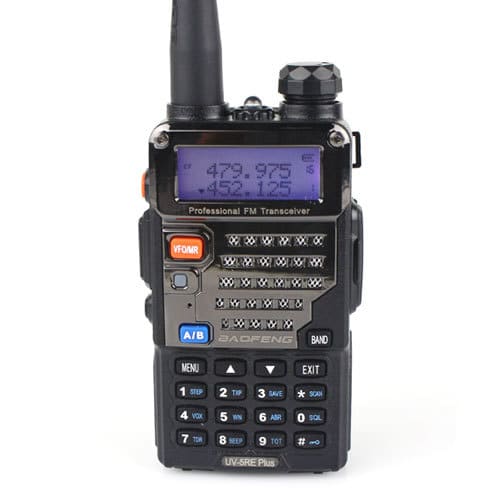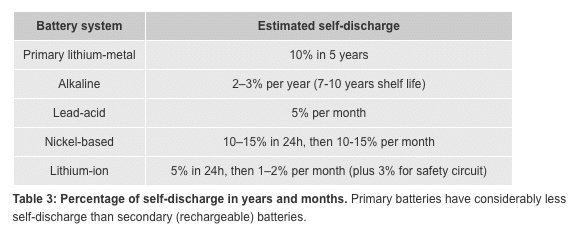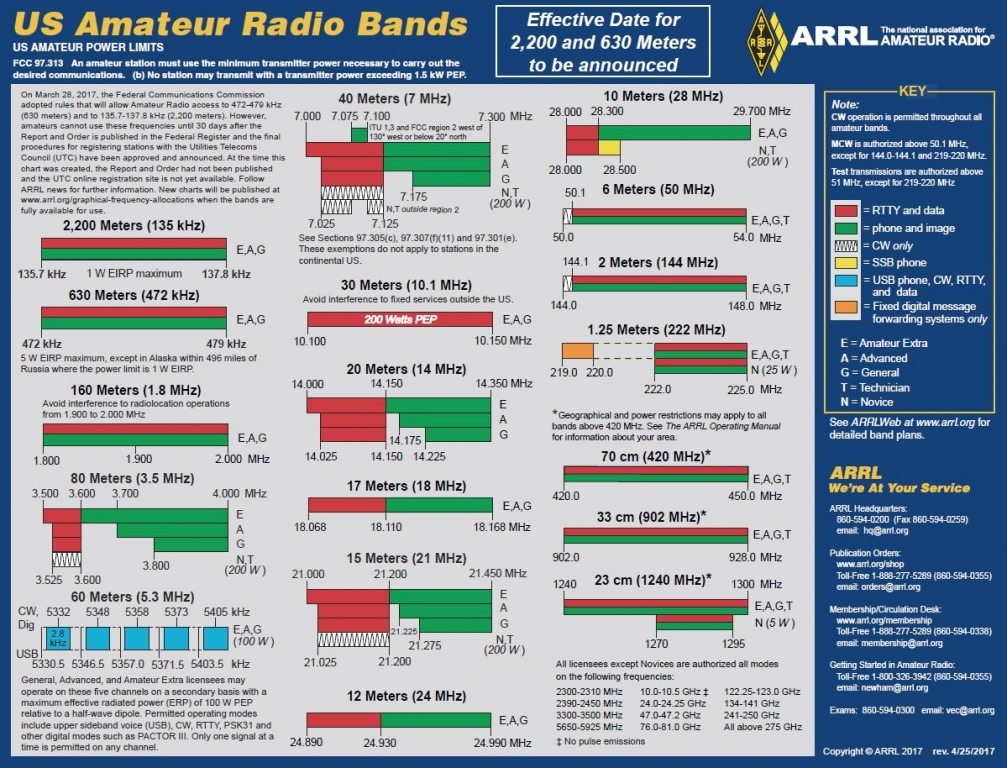Emergency Communications
See summary parent article on prepping priorities.
The two goals for communication are receiving information to learn what you can about the current situation and transmitting information (“I’m here”, “let’s meet there”).
(1) Your most powerful communication tool is your cell phone
You already know how to use this incredibly helpful device. Consider loading it with useful apps, including scanner apps like 5-0 Radio Pro Police Scanner, myTuner radio, and Zello (converts your phone into a walkie talkie).
Next step is making sure you can power it in an emergency. Apple iphone SE has 1900 mAh.
 (2) Your second most powerful communication tool is a dual-band handheld radio that receives and transmits (kind of like your cell phone)
(2) Your second most powerful communication tool is a dual-band handheld radio that receives and transmits (kind of like your cell phone)
You need a license to transmit with these but not to receive. These may be more resilient that a cell phone network and are a good second backup to your cell phone in any case.
Example: Baofeng UV-5RE ($29; also, see this $39 kit that includes everything you need (including an extra battery) except for USB cable for charging battery, an extra $11). Also, consider the Baofeng UV-82 (this article for why).
Receives and Transmits (if you have a GMRS license you can use as a walkie-talkie = simplex; if you have a HAM license you can transmit on HAM bands. In an emergency, you can transmit and get help regardless of whether you have a license or not). It is an FM radio and also receives NOAA weather stations. It doesn’t get short wave frequencies.
Battery capacity is 1800 mAh. Decent manual can be found at Miklor but here are some features to remember: Call & Push to talk buttons: for transmitting (need a license). Press Call button to access FM. Monitor button: Press and hold to suppress the squelch and listen to a frequency; Press to activate flashlight, press again to strobe the light, press again to turn off. VFO/MR: Switches between channel mode and frequency mode. A/B: Swaps from top line to the bottom line. Band: Switches from one band to a different band: VHF (2 meters) or UHF (70 centimeters). Largely redundant button b/c you can just type in a frequency and if it’s in the VHF range, that’s what you’ll get and same with UHF. Menu: This button activates blue short-key cuts and can also access. Antenna connector = SMA male connector on the tranceiver receives a female SMA connector antenna.
Just like an AM/FM radio, you will get nothing but static unless you are tuning in to a station or frequency that you actually receive in your area. Thus, find stations that work and program them into the radio’s memory, just like programming your car stereo to your favorite stations. In this case, you choose a frequency and then hit Menu + 27 + Menu button again to choose channel number you want to save the frequency under + Menu again to actually do the save. Then, when you are in channel mode you can select based on channels you’ve saved. However, the better way to program your radio with the frequencies you want is to use a USB programming cable and free, open-source Chirp software. In this case, you can also name your channels. Episode on programming the radio.
Simplex communications = like a walkie talkie = radio-to-radio direct to each other without a repeater going in between. GRMS license needed to use appropriate frequencies (FCC application costs $70 and family can use as well; GMRS rules); Family Radio Services (FRS) does NOT need a license for FRS channels, but you must follow the rules and need to use only 1/2 watt of power and can’t modify the antenna. Note: HAM license does not cover GMRS frequencies. See the same video for using Chirp software to use existing (or your own) repeater. Program in your local repeaters to enhance communications possibilities in a disaster. (source: video)
Program in NOAA weather stations (see this website for info and frequences). Example of one listing in Wisconsin. For example, Madison, WI receives 162.550.
| Site Name | Transmitter Name | Call Sign | Frequency | Power | WFO |
|---|---|---|---|---|---|
| Gresham | Gresham | KC2XBZ | 162.500 | 300 | Green Bay, WI |
Pull in police, EMS, fire scanning. Program in local relevant stations, looking them up in the reference data by state and county at this website.
A basic course that focuses on the Baofeng.
- Menu 21 (MDF-B – What to display on your B line – Frequency, channel, or name) & 22 (MDF-B – What to display on your B line – Frequency, channel, or name). He sets A to frequency and B to name. Want to know the name, tune B to that frequency and you’ll get the name. Want to know the frequency, put that frequency on A
- Listen to local repeaters: http://www.broadcastify.com/listen/
- He reserves first 20 or so memory channels for call frequences (I think he means simplex family or small group community), NOAA and police/Fire/EMS scanners, then 21-127 memory channels for 2 meter repeaters and then 70 cm frequencies
- Some prepper frequences here
- HAM 2-meter Go Bag. See this video for an example.
- Antennas
- Telescoping 5/8 wavelength whip antenna are recommended by ARRL (example, $26) and a shorter one.
- 14.5″ Rubber duck antenna with a fix that makes it even better (he points out that for enhanced security, you may want to use a shorter antenna when you want to keep your comms local)
- Car mounted magnetic antennas are also recommended by ARRL (example)
- A small and versatile antenna that can be mounted inside a window, outside, hung up in a tree, etc. Some of the reviews suggest you get a lot of signal loss due to the small coax so you really need to get it high to outperform duck antennas.
- Slim Jim antennas are portable and powerful (available here)
- A portable beefy-looking example
- You may want a repeater of your own. If so, check out this article.
- Protect a radio against EMP? Here’s one idea from a reputable source.
Make a Communication Kit for every family member.
Here’s a good article on a well-thought out kit. Combine this with the following ideas for making a kit for each member of the family (see this video, 3:19) that contains:
- Keeping a radio powered in disaster scenario is a bit challenging especially since charged batteries don’t stay that way in storage. So, make sure that whatever radio you get, you can charge it via USB as all of us are much more likely to have access to a USB charger or USB battery than a Baofeng charging cradle (which is still not going to do any good in a power shortage). The Baofeng UV-3R radio can be charged via USB right out of the box but it costs $75 on Amazon. Instead, the UV-3RE ($29) + an extended battery ($16; see this video for example)+ a USB charging cable ($11) for a total of $56 and change. Alternatively, just get a cable that goes from a female cigarette lighter type socket to USB (example), but check that the voltages will work for the radio (see below). There are also extended batteries that can be charged via usb (see, for example). Another mod of the charger (which takes 10 v input) so that it can take 14 volts from car cig lighter. It’s also possible to modify a battery so it can be charged via usb: here’s an example of that process.
- For charging, a note about amps and volts. Be careful, Baofeng cradle needs 10 volts and many cables advertised as compatible produce more than 12 volts. It would be great to find a USB charging cable with the ability to select volt output – volts need to be right for your device. Amps will just determine how fast a device charges and most devices can regulate that. One exception is if you are charging batteries directly. In that case use a smart battery charger like this one for that.
- All batteries lose charge in storage. For battery storage life, see this
Source: https://batteryuniversity.com/index.php/learn/article/elevating_self_discharge article. The table is a basic summary. Primary batteries self-discharge less than rechargeable batteries. So, if you are using lithium-ion rechargeable batteries for your radio (typical), a fully charged battery will last for about 20 months. However, there’s an additional issue related to a battery’s capability of recharging once it’s reached a certain level of discharge rate and this depends on storage temperatures (in general, higher temps are worse, but when temps fall below zero, it will significantly discharge a Li-ion battery very quickly as well). Without doing more research, I would swap and charge batteries every 6 months. For battery life by batttery type during radio use, see this post of tests done.
- Program your family’s radios with frequencies needed.
- Using the cradle charger, you can use AC outlet, DC outlet or USB charger cable. You can also use a clamshell battery pack for AA batteries or a different one for Li-ion batteries if you can find one. This last is probably the simplest idea. A smaller go-bag idea with two interesting antenna options, including a titanium whip antenna and a j-pole.
- Laminated card telling people what to do (1: Found by you; 2: Found by anyone) – 2 channels – a fairly unknown channel and another universal call-for-help in North America call frequency. Sample instructions: Once every 2 minutes, hold down PTT and talk for 30 seconds. Do this for 30 minutes. Refer to plan: establish communications, go to rendezvous spot that is only indicated on the instruction card. Can use APRS to transmit location (advanced). PRACTICE. A frequency plan add-on: 5 or so frequencies you agree on that you may rotate every 3 minutes or even the frequencies themselves change according to the date in some easy-to-remember way.
HAM radio.
Need HAM technician license to talk on UHF and VHF bands but not required in emergency situation. Can find stations using this website. You can LISTEN to (but not transmit without a license) Amateur Radio Emergency Services (ARES, Dane County, WI ARES/RACES). Example of training courses recommended or required.) groups who may have weather or disaster information before other stations. Dane County Amateur Emergency. Repeaterbook.com for relevant frequencies.
- VHF (short range) is reliable and clear and so used for local communications by police, air traffic, FM, etc. VHF is 30 to 300 Mhz. HAM frequencies are in the middle = 144-148 Mhz. Not affected by weather, etc. but does depend on line-of-sight = radio horizon. Can extend this by connecting to repeaters, publically available for HAM operators — The higher the antenna, the greater the radio horizon. You can also set up your own repeater. Source.
- UHF communications allows you to talk to the world = long-range, 3-30 Mhz. These frequencies have different characteristics — they bounce off the ionosphere = skip propogation and can facilitate communication beyond line of sight. There is only your radio and the other radio with no infrastructure in between. HF takes more equipment and a general license. Cost of entry is $1000. Gigaparts.com is a good vendor. Source.
- Getting HAM license. Technicians (can access short range, 26/35 questions correct out of 400 item pool), General (opens up voice, data, and cw priveleges to talk to the world), Extra license – each builds on the other and unlocks new possibilities. How to get HAM license in 7 days. Personally, I studied Technician Class 2014-18 FCC Element 2 Radio License Preparation by Gordon West (WB6NOA) and Eric P. Nichols (KL7AJ) and valued their comments. I got the book delivered on 7/19/17, took the technician test on 8/5/17 and had my call sign from the FCC (KD9JCM) on 8/14/17. You have as much time as you need to take the the $15 test and you can take all 3 tests on the same day for no extra charge if you wish. Tests are administered by VEs = volunteer HAM folks. You can’t transmit until your name is in the FCC database and you get a call sign. There are currently 725,000 HAM operators. Search here for a test near you.
(3) Your next best communications to add to the above are a Short-wave radio and a simple AM/FM Radio.
TECSUN Short-Wave Radio
Save
Save
Save
Save
Save
Save
Save
Save
Save
Save
Save
Save
Save
Save
Save
Save
Save
Save
Save
Save
Save
Save
Save
Save
Save
Save
Save
Save
Save
Save
Save
Save
Save
Save
Save
Save
Save
Save
Save
Save
Save
Save
Save
Save
Save
Save
Save
Save
Save
Save
Save
Save
Save
Save
Save
Save
Save
Save
Save
Save
Save



Pingback: Short-term resilience: Disasters | One Planet Thriving
Pingback: Emergency or Backup Energy | One Planet Thriving
Pingback: Emergency Car Kit | One Planet Thriving